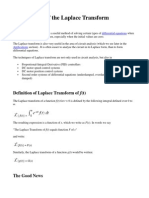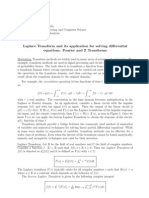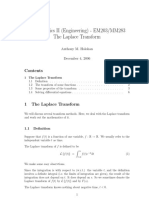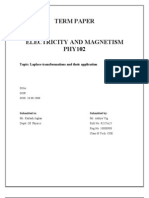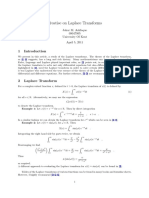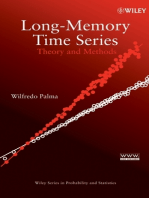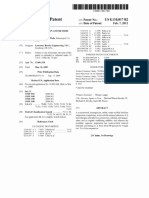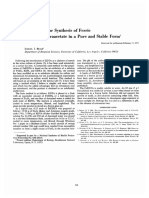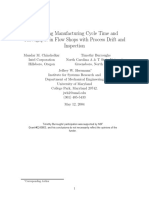The Laplace Transformation
Uploaded by
Mostafa FawzyThe Laplace Transformation
Uploaded by
Mostafa FawzyChapter 2
The Laplace Transformation
The Laplace Transform is a powerful technique for analyzing linear time-
invariant systems such as electrical circuits and mechanical systems. Given
a simple mathematical or functional description of an input or output to a
system, the Laplace transform provides an alternative functional description
that often simplies the process of analyzing the behavior of the system,
or in synthesizing a new system based on a set of specications. In actual
physical systems the Laplace transform is often interpreted as a transforma-
tion from the time-domain (inputs and outputs are functions of time), to
the frequency-domain (inputs and outputs are functions of complex angular
frequency, or radians per unit time). This transformation not only provides
a fundamentally dierent way to understand the behavior of the system, but
it also drastically reduces the complexity of the mathematical calculations
required to analyze the system.
This integral transform has a number of properties that make it useful for
analysing linear dynamical systems. A signicant advantage is that dier-
entiation and integration become multiplication and division, respectively.
(This is similar to the way that logarithms change an operation of multi-
plication of numbers to addition of their logarithms.) This changes integral
equations and dierential equations to polynomial equations, which are much
easier to solve. It is a powerful tool for solving a wide variety of initial-value
problems.
Denition
If h(t) is a continuous function with t 0 the Laplace Tranform for h(t) is
H(s):
L{h(t)} = H(s) =
_
0
h(t)e
st
dt.
although in many cases the variable s is a real number, it is in general a
complex number, s = + j. A sucient condition for the existence of the
1
Laplace Transform is
_
0
|h(t)|e
1
t
dt <
for a real positive
1
. Thus, as t , |h(t)| cannot be greater than e
1
t
.
Relationship between the Fourier Transform
and the Laplace Transform
If h(t) is causal, then h(t) = 0 for t < 0, and in addition:
_
0
|h(t)| < ,
then the Fourier Transform of h(t) exists and is equal to:
F{h(t)} = H() =
_
0
h(t)e
jt
dt.
A comparison with the Laplace Transform is then:
F{h(t)} = L{h(t)}|
s=j
.
The Laplace transform can be viewed as a generalization of the Fourier
transform from the real line (a simple frequency axis) to the entire complex
plane. The Fourier transform is obtained by evaluating the Laplace transform
along the axis in the complex plane. For many functions, there exists a
Laplace transform, yet none exists for the Fourier transform.
The Inverse Transformation
In the general case, the inverse Laplace transform is the Bromwich integral,
which is complex integral given by
h(t) = L
1
{H(s)} =
1
2j
_
+j
j
e
st
H(s)ds.
Very often the function H(s) can be decomposed into by partial fractions
into a sum of elementary functions, whose individual Laplace transformations
can be found trivially (for example the following tables), and the overall
Laplace transformation can be obtained using the linearity property of the
transform.
2
Simple Laplace Transforms
In each case, h(t) = 0 for t < 0.
h(t) = (t) H(s) = 1
h(t) = u
0
(t) = 1 H(s) =
1
s
, s > 0
h(t) = t
n
H(s) =
n!
s
n+1
, s > 0, n > 0
h(t) = e
at
H(s) =
1
s a
, s > a
h(t) = t
n
e
at
H(s) =
n!
(s a)
n+1
, s > a, n > 0
h(t) = sin at H(s) =
a
s
2
+ a
2
, s > 0
h(t) = cos at H(s) =
s
s
2
+ a
2
, s > 0
h(t) = e
at
sin bt H(s) =
b
(s a)
2
+ b
2
, s > a
h(t) = e
at
cos bt H(s) =
s a
(s a)
2
+ b
2
, s > a
h(t) = sinh at H(s) =
a
s
2
a
2
, s > |a|
h(t) = cosh at H(s) =
s
s
2
a
2
, s > |a|
Important Characteristics of the Laplace
Transform
Given the functions h(t) and g(t), and their respective Laplace transforms
H(s) and G(s):
Linearity
L{c
1
h(t) + c
2
g(t)} = c
1
H(s) + c
2
G(s)
Time Shifting
L{h(t c)} = e
cs
H(s)
Frequency Shifting
L{e
at
h(t)} = H(s a)
3
Scaling
L{h(ct)} =
1
|c|
H(
s
c
)
Dierentiation
L{h
(t)} = sH(s) h(0)
L{h
(t)} = s
2
H(s) sh(0) h
(0)
L{h
n
(t)} = s
n
H(s) s
n1
h(0) ... h
n1
(0)
Integration
L
__
t
0
h()d
_
=
1
s
H(s)
Convolution
L
__
h()g(t )d
_
= L{h(t) g(t)} = H(s)G(s)
Examples
Laplace Transformation of a -function
The -function is not a function is in the conventional sense. A mathemati-
cally exact description requires Distribution Theory. We approximate the
function as a rectangular function of height 1/ and width :
(t) = lim
0
_
_
0 t < 0
1/ 0 < t <
0 t >
As approaches 0, then (t) becomes inntely narrow and innitely high.
In addition, the delta function is constrained to satisfy the following re-
lationship:
_
(t)dt = lim
0
_
dt = lim
0
_
0
1
dt = lim
0
_
t
0
= 1.
The Laplace Transformation of the -function is:
L{(t)} = lim
0
_
0
1
e
st
dt = lim
0
_
1
s
e
st
_
0
= lim
0
1 e
s
s
.
Following LHopitals rule:
L{(t)} = lim
0
se
s
s
= 1.
4
Laplace Transformation of a Step Function
The Heaviside Function, or step function is dened as
u
0
(t) =
_
0 t < 0
1 t > 0
The Laplace Transform of a step function is:
L{u
0
(t)} =
_
0
1e
st
dt =
_
e
st
s
_
0
=
1
s
.
This result can also be obtained from the fact that the step function is the
integral of the -function, using the the integration property of the Laplace
Transform. (Excercise)
Time shifting
H(s) is the Laplace transform of h(t). If h(t c) is a step function shifted
to the right by an amount / time c. Since by denition h(t) = 0 for t < c,
then it must also hold that h(t) = 0 for t < 0.
The Laplace Transformation for h(t c) is:
L{h(t c)} =
_
0
h(t c)e
st
dt =
_
c
h(t c)e
st
dt
with a variable substitution t = + c we nd
L{h(t c)} =
_
0
h()e
s(+c)
d = e
cs
_
0
h()e
s
d = e
cs
H(s).
In order to satisfy explicitly the condition that h(t c) = 0 for t < c , various
texts include the following adjustment:
L{u
c
(t)h(t c)} = e
cs
H(s),
where u
c
(t) is the Heaviside step function with t = c:
u
c
(t) = u
0
(t c) =
_
0 t < c
1 t > c
Laplace Transformation of the Derivative of a Function
H(s) is the Laplace Transform and h
(t) is the derivative of the function
h(t). The Laplace Transform of h
(t) is easily determined using integration
by parts:
L{h
(t)} =
_
0
h
(t)e
st
dt =
_
h(t)e
st
_
_
0
h(t)(s)e
st
dt
5
L{h
(t)} = h(0) + s
_
0
h(t)e
st
dt = sH(s) h(0).
When h(0) = 0, the Laplace transform of the derivative of the function is
equivalent to a multiplication by s, and the transform of the integral of a
function is equivalent to a division by s.
Exercise
given a linear dierential equation of the second order with the form
y + b y + cy = x
Task: determine the Laplace transform of this equation and solve for Y (s)
under the assumption that all the initial conditions are 0 (i.e. y(0) = 0 und
y(0) = 0).
6
You might also like
- ECM2105 Control: Prathyush P Menon, Christopher Edwards Date: 20-Jan-2014, Room H101No ratings yetECM2105 Control: Prathyush P Menon, Christopher Edwards Date: 20-Jan-2014, Room H10118 pages
- Mathematics II (Engineering) - EM203/MM283 The Laplace TransformNo ratings yetMathematics II (Engineering) - EM203/MM283 The Laplace Transform6 pages
- Laplace Transforms and Its Applications: Unit-IiiNo ratings yetLaplace Transforms and Its Applications: Unit-Iii68 pages
- Chapter-2 Laplace Transform: Definition of The Laplace TransformationNo ratings yetChapter-2 Laplace Transform: Definition of The Laplace Transformation15 pages
- WIN SEM (2023-24) FRESHERS - MAT1002 - TH - AP2023247000225 - 2024-02-29 - Reference-Material-INo ratings yetWIN SEM (2023-24) FRESHERS - MAT1002 - TH - AP2023247000225 - 2024-02-29 - Reference-Material-I18 pages
- Lecture Guide 3 - Laplace Transformation For Process ControlNo ratings yetLecture Guide 3 - Laplace Transformation For Process Control17 pages
- Signal and Systems Chapter Five Laplace TransformNo ratings yetSignal and Systems Chapter Five Laplace Transform24 pages
- Module 3.1 Lapalce Transform of Periodic FunctionsPartial Differential EquationsNo ratings yetModule 3.1 Lapalce Transform of Periodic FunctionsPartial Differential Equations15 pages
- (9-11) Introduction To Laplace TransformNo ratings yet(9-11) Introduction To Laplace Transform3 pages
- Student Solutions Manual to Accompany Economic Dynamics in Discrete Time, secondeditionFrom EverandStudent Solutions Manual to Accompany Economic Dynamics in Discrete Time, secondedition4.5/5 (2)
- The Pharmaceutics and Compounding LaboratoryNo ratings yetThe Pharmaceutics and Compounding Laboratory1 page
- Chemical Disinfectants - Disinfection & Sterilization Guidelines - Guidelines Library - Infection Control - CDCNo ratings yetChemical Disinfectants - Disinfection & Sterilization Guidelines - Guidelines Library - Infection Control - CDC14 pages
- United States Patent (10) Patent No.: US 8,110,017 B2No ratings yetUnited States Patent (10) Patent No.: US 8,110,017 B212 pages
- EP2268594A2 - Fertilizer Suspension and Method of Preparation - Google PatentsNo ratings yetEP2268594A2 - Fertilizer Suspension and Method of Preparation - Google Patents1 page
- HLB Hydrophylic-Lipophilic Balance CalculatorNo ratings yetHLB Hydrophylic-Lipophilic Balance Calculator1 page
- How To Calculate Overall Equipment Effectiveness: A Practical GuideNo ratings yetHow To Calculate Overall Equipment Effectiveness: A Practical Guide1 page
- General Chemistry 11 Chapter Cement Water OilNo ratings yetGeneral Chemistry 11 Chapter Cement Water Oil92 pages
- Antiseptics: Iodophors, Iodine, and IodideNo ratings yetAntiseptics: Iodophors, Iodine, and Iodide2 pages
- Streptococeusfaecalis: Iron Requirement and Chelator Production of Staphylococci, and Enterobacteriaceae J. HNo ratings yetStreptococeusfaecalis: Iron Requirement and Chelator Production of Staphylococci, and Enterobacteriaceae J. H11 pages
- Just in Time: Pawan Sehrawat (Voltas LTD.)No ratings yetJust in Time: Pawan Sehrawat (Voltas LTD.)21 pages
- Objective of MRP and MRP2 in Computer StudyNo ratings yetObjective of MRP and MRP2 in Computer Study14 pages
- Presented By: Rincy Joseph (69) Surbhi Gupta (71) Sugandha Vidge (80) Parana Vijay (110) Dulguun TurbatNo ratings yetPresented By: Rincy Joseph (69) Surbhi Gupta (71) Sugandha Vidge (80) Parana Vijay (110) Dulguun Turbat29 pages
- Honeywell Analytics Calibration Handbook 2016No ratings yetHoneywell Analytics Calibration Handbook 2016164 pages
- Typical Joint Detailing of Steel Hollow SectionsNo ratings yetTypical Joint Detailing of Steel Hollow Sections7 pages
- Y5 Autumn Block 5 Wo3 Area of Rectangles 2019No ratings yetY5 Autumn Block 5 Wo3 Area of Rectangles 20192 pages
- Advantages and Disadvantages of air coolerNo ratings yetAdvantages and Disadvantages of air cooler152 pages
- Rajasthan Board Class 12 Physics Ss 40 1 2018No ratings yetRajasthan Board Class 12 Physics Ss 40 1 20188 pages
- 1U Switching Power Supplies: InstallationNo ratings yet1U Switching Power Supplies: Installation2 pages
- ECM2105 Control: Prathyush P Menon, Christopher Edwards Date: 20-Jan-2014, Room H101ECM2105 Control: Prathyush P Menon, Christopher Edwards Date: 20-Jan-2014, Room H101
- Mathematics II (Engineering) - EM203/MM283 The Laplace TransformMathematics II (Engineering) - EM203/MM283 The Laplace Transform
- Chapter-2 Laplace Transform: Definition of The Laplace TransformationChapter-2 Laplace Transform: Definition of The Laplace Transformation
- WIN SEM (2023-24) FRESHERS - MAT1002 - TH - AP2023247000225 - 2024-02-29 - Reference-Material-IWIN SEM (2023-24) FRESHERS - MAT1002 - TH - AP2023247000225 - 2024-02-29 - Reference-Material-I
- Lecture Guide 3 - Laplace Transformation For Process ControlLecture Guide 3 - Laplace Transformation For Process Control
- Module 3.1 Lapalce Transform of Periodic FunctionsPartial Differential EquationsModule 3.1 Lapalce Transform of Periodic FunctionsPartial Differential Equations
- Student Solutions Manual to Accompany Economic Dynamics in Discrete Time, secondeditionFrom EverandStudent Solutions Manual to Accompany Economic Dynamics in Discrete Time, secondedition
- Chemical Disinfectants - Disinfection & Sterilization Guidelines - Guidelines Library - Infection Control - CDCChemical Disinfectants - Disinfection & Sterilization Guidelines - Guidelines Library - Infection Control - CDC
- United States Patent (10) Patent No.: US 8,110,017 B2United States Patent (10) Patent No.: US 8,110,017 B2
- EP2268594A2 - Fertilizer Suspension and Method of Preparation - Google PatentsEP2268594A2 - Fertilizer Suspension and Method of Preparation - Google Patents
- How To Calculate Overall Equipment Effectiveness: A Practical GuideHow To Calculate Overall Equipment Effectiveness: A Practical Guide
- Streptococeusfaecalis: Iron Requirement and Chelator Production of Staphylococci, and Enterobacteriaceae J. HStreptococeusfaecalis: Iron Requirement and Chelator Production of Staphylococci, and Enterobacteriaceae J. H
- Presented By: Rincy Joseph (69) Surbhi Gupta (71) Sugandha Vidge (80) Parana Vijay (110) Dulguun TurbatPresented By: Rincy Joseph (69) Surbhi Gupta (71) Sugandha Vidge (80) Parana Vijay (110) Dulguun Turbat

